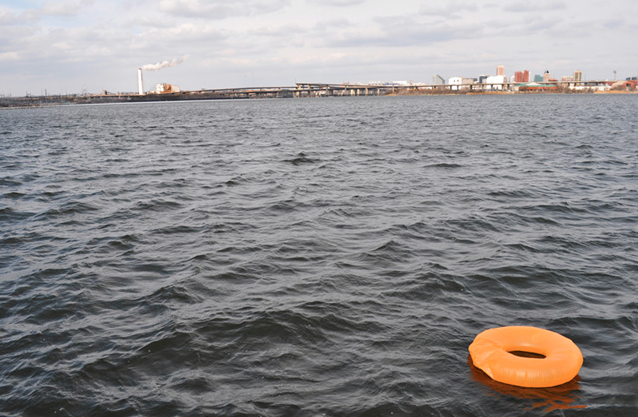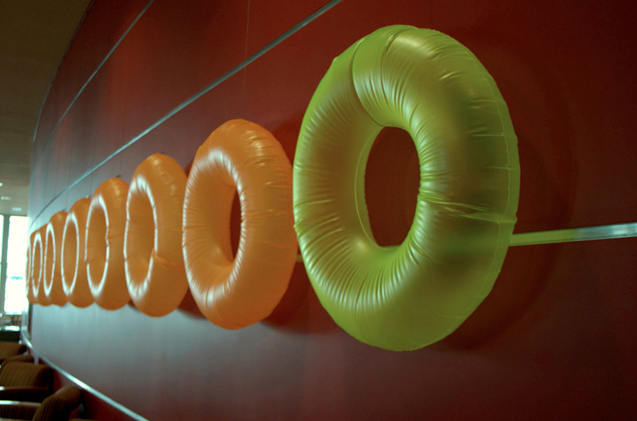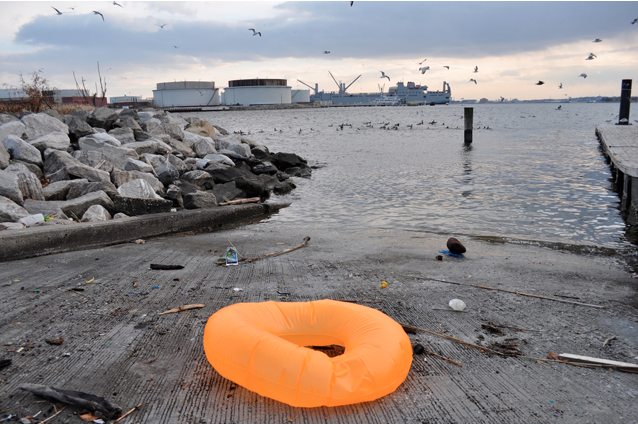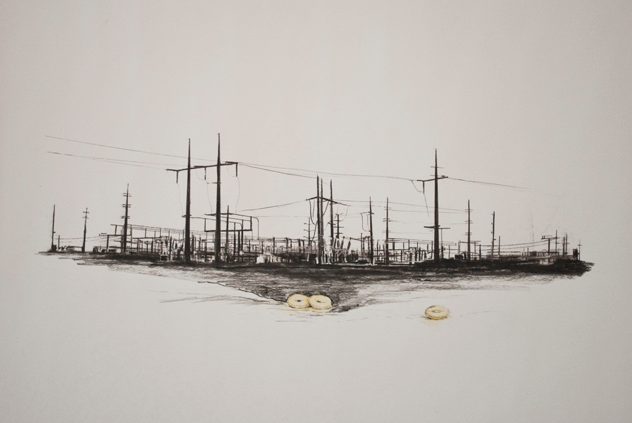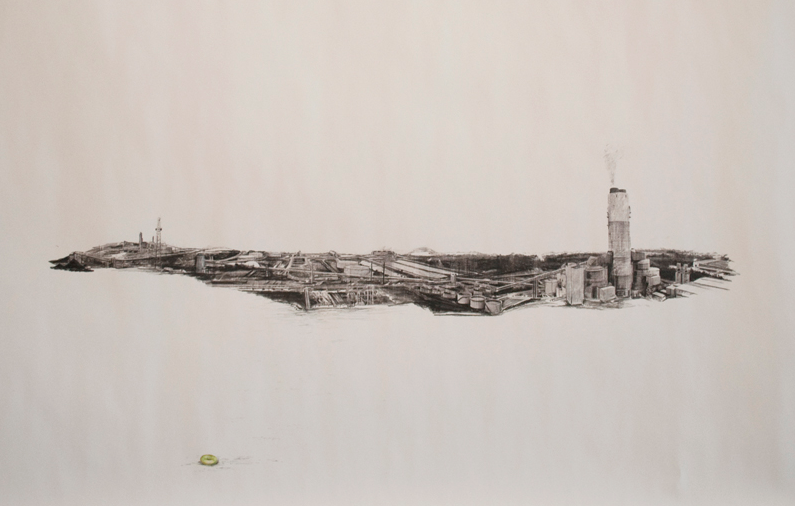A solitary neon inflatable tube glows against slate harbor water. The very shade of a yellow hi-lighter, it rests lightly atop a shameful mound of litter and debris, sharing the frame with a line of swimming ducks. Runoff (pictured above) is a photograph in Empty Waters, a comprehensive multi-media project by Eileen Wold, that raises consciousness about the local industrial landscape. A thin horizon with the iconic waste-to-power smokestack and wrapping highway appear distantly miniature in Baltimore Resco (pictured below). A bright orange tube in the foreground evokes a stab of irony, coupled with the memory of an innocent pastime. On her website, Wold cites that “Baltimore’s health department warns swimming in the harbor should be avoided due to the risk of disease from bacteria.”
The connection of the tube, as a life saver, correlates to the land and water in dire need of preservation. They become bright exclamation points in each of Wold’s photographs. The single tube embodies the artist’s observation of our society and culture which fuels the faceless factory with our increasing need for power. In a recent exhibit at the University of Maryland, Baltimore , the artist lined the walls outside the dining hall doors with the inflatable tubes, confronting and engaging hundreds of viewers about the landscape just blocks away from campus.
Rather than presenting an aggressive or didactic vision, Wold creates quietly powerful imagery which sparks crucial questions about energy production. Environmental issues are explored on a local and global level, holding a mirror to the changing landscape and our perceptions.
Empty Waters focuses on the Chesapeake Bay, a highly contaminated yet vital body of water, the largest estuary in North America. Her multi-media and multi-disciplinary approach spans photography, drawing, sculptural installation, and video. The artist creates performances, placing the neon tubes in polluted waterways and photographing and filming the results. Panoramic charcoal drawings of the Brandon Shores and C.P. Crane Power Plants illustrate her ideas as well. Wold edits her works into soundless videos, where people at play at a summertime water-park contrast alternately with the tube and harbor footage. She connects with scientists, journalists, economists, and developers to inspire and inform her artistic practice. Making her home in Baltimore, she earned her BFA from Loyola in 2000, and MFA from MICA in 2010. Wold’s recent work has been shown in both public institutions and gallery settings, creating a wide cross section of viewers.
Eileen Wold once sought out serene, ethereal surroundings as a landscape painter. After moving to New York City over ten years ago, the smokestacks of Northern New Jersey crept into her paintings until they became the main subjects. Making frequent trips between New York and Baltimore, Wold began to study the Colonial pipeline, photographing the refineries along Route 95 that would serve as studies for paintings. Over time, the isolated factory portraits became wide, panoramic drawings of endless refineries, installed in a gallery space that completely surrounded the viewer. Wold’s work addresses what may prove to be the most significant issue in contemporary life: our cultural dependence on fossil fuels, and how those forces alter the landscape.
Aerial photographs, video of a trickling stream, and graphite drawings that trace the scars and craters of the land were part of a six month exploration of Baltimore’s coal station source in West Virginia. Touring Resco, a Baltimore power plant, and others, were humbling experiences for Wold as an environmental artist. “It can be so easy to view them as a problem, or an enemy in the fight for conservation, but the reality is they are stressed out trying to meet our demands for energy, that you suddenly see them as part of the greater cultural problem, and I become less the victim, and am implicated as a person in this society that is also putting pressure on the power grid.” This very heightening of awareness through research, in depth exploration, and expression of the landscape is the quintessence of Wold’s work.
Fragmented Remains, a one year, one mile investigation expressed through photography, sculptural installation and drawing was exhibited at InFlux gallery this spring. Wold spent weeks at the shoreline along the Gwynns Falls, behind Harbor Hospital, collecting and recycling trash. Becoming overwhelmed with the incessant amount of litter, she decided to remove every fragment of debris from marked 52 inch squares. “This proved to be difficult because the natural matter was so intertwined with the plastics and man made substances that, at times, I was not sure which was which. There were remains of birds mixed in with bits of styrofoam.” In a group show called Water Sonnettos, before and after photographs of the cleared square, along with installations of the actual trash, gave a sense of scale and scope. A sketchy cassette tape rendered in charcoal, is cradled by yellow rubber-gloves, suggesting the tension between sentimentality and waste. Wold’s honest drawings are particularly poignant, evoking the story of an object as a cultural commodity.
In her developing body of new work, Wold is currently observing and documenting the plant and animal life that inhabit a former commercial retail space. The lot of a vacant big box store, located on bastardized waterfront real estate, has become an industrial meadow. Wold plans on doing guerrilla planting at this South Baltimore location next spring. She will source native plants to beautify the space. Her research topics will include the loss of the meadow as a critical habitat, gaining additional perspectives from a biologist from the Smithsonian and the property owners. Using her signature multi-media and multi-sensory palette, Wold will continue to explore the juxtaposition of culture and nature’s affect on the landscape. The consequences of development, abandonment, and adaptive nature define the lifecycle of this place. The artist becomes an informal expert and storyteller, and the artwork becomes a tool for reflection, conversation, and awareness.
Wold is sharing her expertise and artistic practice this semester at MICA, teaching the interdisciplinary course “Climate Change and Sustainability for Artists and Designers.” The main topics explored during the semester are energy, food, climate change, and carbon footprint. She has given her students a true taste of a day’s labor at Simmer Rock Farm, an organic vegetable operation in Sparks, MD. In a trip to the Smithsonian Environmental Research Center (SERC) on the western shore of the Chesapeake Bay, her students learned about the ecosystem of the marshland through hands-on experiences with biologists. She describes her students as bright and innovative, and that they also inspire her through their research in developing their work.
“I think we all sincerely want and seek out those moments alone on the beach or hiking on a mountain in search for some insight into our own existence as humans,” Wold explains. “We want to fish and not worry about if the water has mercury or arsenic in it. This is where humanity clashes with culture, and as an artist, it is an interesting thing to watch as we progress farther away as each moment with the natural world is mediated, shaped by cultural constructs we see in movies, tv, park signage, religion, advertisements and story telling.” Through her multi-media explorations, Wold’s highly accessible work retains a fluid curiosity and sensitive rendering of the landscape. She explores complex regional and global environmental issues, creating a springboard for informative dialogue with the viewer.
More of Eileen Wold’s work can be seen at eileenwold.com
Author: Jill Gordon is an urban explorer, fiber artist, and writer who is both enamored and bewildered by the grit and vitality found in her fair city. She is a member of Mother Made Baltimore, www.mothermadebaltimore.org, and can be contacted at [email protected].

